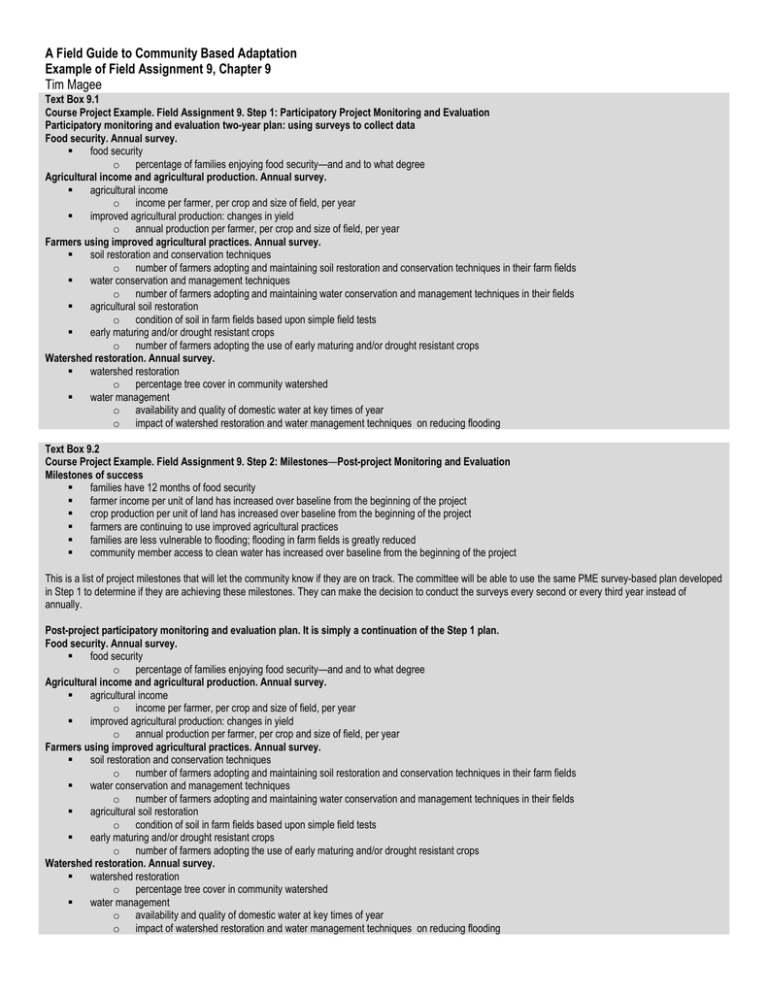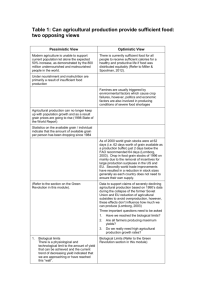
A Field Guide to Community Based Adaptation
Example of Field Assignment 9, Chapter 9
Tim Magee
Text Box 9.1
Course Project Example. Field Assignment 9. Step 1: Participatory Project Monitoring and Evaluation
Participatory monitoring and evaluation two-year plan: using surveys to collect data
Food security. Annual survey.
food security
o percentage of families enjoying food security—and and to what degree
Agricultural income and agricultural production. Annual survey.
agricultural income
o income per farmer, per crop and size of field, per year
improved agricultural production: changes in yield
o annual production per farmer, per crop and size of field, per year
Farmers using improved agricultural practices. Annual survey.
soil restoration and conservation techniques
o number of farmers adopting and maintaining soil restoration and conservation techniques in their farm fields
water conservation and management techniques
o number of farmers adopting and maintaining water conservation and management techniques in their fields
agricultural soil restoration
o condition of soil in farm fields based upon simple field tests
early maturing and/or drought resistant crops
o number of farmers adopting the use of early maturing and/or drought resistant crops
Watershed restoration. Annual survey.
watershed restoration
o percentage tree cover in community watershed
water management
o availability and quality of domestic water at key times of year
o impact of watershed restoration and water management techniques on reducing flooding
Text Box 9.2
Course Project Example. Field Assignment 9. Step 2: Milestones—Post-project Monitoring and Evaluation
Milestones of success
families have 12 months of food security
farmer income per unit of land has increased over baseline from the beginning of the project
crop production per unit of land has increased over baseline from the beginning of the project
farmers are continuing to use improved agricultural practices
families are less vulnerable to flooding; flooding in farm fields is greatly reduced
community member access to clean water has increased over baseline from the beginning of the project
This is a list of project milestones that will let the community know if they are on track. The committee will be able to use the same PME survey-based plan developed
in Step 1 to determine if they are achieving these milestones. They can make the decision to conduct the surveys every second or every third year instead of
annually.
Post-project participatory monitoring and evaluation plan. It is simply a continuation of the Step 1 plan.
Food security. Annual survey.
food security
o percentage of families enjoying food security—and and to what degree
Agricultural income and agricultural production. Annual survey.
agricultural income
o income per farmer, per crop and size of field, per year
improved agricultural production: changes in yield
o annual production per farmer, per crop and size of field, per year
Farmers using improved agricultural practices. Annual survey.
soil restoration and conservation techniques
o number of farmers adopting and maintaining soil restoration and conservation techniques in their farm fields
water conservation and management techniques
o number of farmers adopting and maintaining water conservation and management techniques in their fields
agricultural soil restoration
o condition of soil in farm fields based upon simple field tests
early maturing and/or drought resistant crops
o number of farmers adopting the use of early maturing and/or drought resistant crops
Watershed restoration. Annual survey.
watershed restoration
o percentage tree cover in community watershed
water management
o availability and quality of domestic water at key times of year
o impact of watershed restoration and water management techniques on reducing flooding
Text Box 9.3
Course Project Example
Field Assignment 9. Step 3: Participatory Monitoring and Evaluation (PME)
Activity 3. Developing a plan for finding future technical and financial support partners
I arranged a meeting with the committee to go through this exercise. We identified seven current organizational partners that they could approach for assistance.
INTECAP: Guatemalan Government/private sector partnership that provides vocational training
MAGA: Guatemalan Ministry of Agriculture
University of San Carlos Department of Agriculture
University of San Carlos Department of Forestry
INAB: National Forestry Institute
MARN: Guatemalan Ministry of the Environment and Natural Resources
SESAN: Guatemalan Secretariat of Food Security and Nutrition
I spoke with the committee about the long-term nature of maintaining the program components. We discussed the possibility that in 20 years they might run into a
problem where they need technical assistance. We also discussed the fact that the committee members might change, and contacts at the institutions might change.
We listed ways that new committee members could start fresh and contact new people for technical assistance.
Here are a series of steps that future committee members could take to find new experts and resources:
1. Keep the original project documentation in a safe place for presentation to a new, potential contact.
2. Keep a list of the main program components that have been maintained by the community.
3. Photocopy a standard Guatemala map showing the location of the community.
4. Write a half page summary describing the problem.
5. Take several photographs of the challenge they are experiencing. In the case of plant problems, provide a sample.
6. Determine if solving the challenge would require a visit by an expert to the community.
7. Ask village leaders from surrounding communities if they know of NGOs that are currently working in the communities.
8. Meet with a member of the NGO to see if they can provide technical assistance for the problem at hand.
9. Do any community members (or or their relatives) attend university or work at one of the institutions listed above?
10. Get someone with a good telephone presence to call the appropriate organizations listed above. Ask for contact information for specific people and get their
telephone numbers.
11. Call these technical experts and very briefly describe the problem and ask if they could provide assistance.
12. Let contacts know that you would be available to travel to their office and bring photographs and samples.
13. Upon identifying the most appropriate person to provide technical assistance, develop a plan to work with them.
14. Determine if this would be a free extension service, or if there would be costs involved.
Text Box 9.4
Course Project Example
Field Assignment 9. Step 4: Developing a Long-Term Project Management Plan
Activity 1. Developing a committee plan for long-term management and maintenance of the project
The Step 2 participatory monitoring and evaluation plan identifies project elements that committee members will want to continue managing in an effort to maintain
resilience to a changing climate. Having this PME plan simplifies the development of the management plan because they are essentially the same.
Community Agricultural Committee Long-Term Management Plan
These are the long-term adaptation outputs and outcomes the community hopes to maintain:
Milestone indicators of success from Step 2
families have 12 months of food security
farmer income per unit of land has increased over baseline from the beginning of the project
crop production per unit of land has increased over baseline from the beginning of the project
farmers are continuing to use improved agricultural practices
families are less vulnerable to flooding; flooding in the village and farm fields is greatly reduced
community member access to clean water has increased over baseline from the beginning of the project
The Community Agricultural Committee needs to be responsible for the following actions as part of the management plan.
1. The monitoring and evaluation plan and the long-term management plan should be a permanent part of committee activities.
2. The committee shall monitor whether farmers and community members are continuing support activities and encourage them to reinstate them if they
aren't.
Encourage farmers to continue using soil conservation and restoration techniques
Encourage farmers to continue using water conservation and management techniques
Encourage farmers to continue using crops appropriate for the changing climate conditions
Encourage community members to be good stewards of the reforested watershed
Encourage community members to properly manage and maintain water management techniques and infrastructure
Encourage farmers to continue successful agricultural income activities
3. Monitoring data shall be routinely evaluated to determine if project outputs and outcomes are successful.
4. If not, the committee should evaluate support activities to see if they are still effective or if they need to be fine-tuned.
5. When a challenge arises, and the community needs outside support, the committee will need to take action and find expert support.
Since the outputs and outcomes in the PME plan are virtually identical to those in the management plan, it should be straightforward for the committee to continue
oversight of project activities.
Text Box 9.5
Course Project Example
Field Assignment 9. Step 5: Packaging and Presenting This Post-project Toolkit
Activity 3. Present final report to community
I typed up a copy of the post-project monitoring and evaluation plan, the plan for seeking future expert support, and the long-term management plan, returned to the
committee, and went through it carefully. I asked for feedback and questions throughout the presentation in order to make sure that the information was easily
understood. They agreed that it was what we had been discussing and we're happy with the presentation.
Lastly, I spoke with the committee about the fact that we had planned for follow-up meetings with them every three months for one year, and then a final project
evaluation at the end of that year. Beyond that, we did not have funding to continue the follow-up. I suggested that I would contact them a few weeks before my
quarterly follow-up meetings so that they could prepare a list of questions or challenges that they would like to discuss with me. Everyone was fine with this
arrangement—the committee felt that the project was clearly defined, that there had been enough capacity building, and that one year of follow up would be
sufficient.
Copyright © 2012, Tim Magee. All rights reserved.



